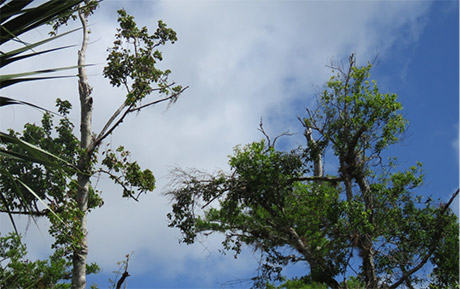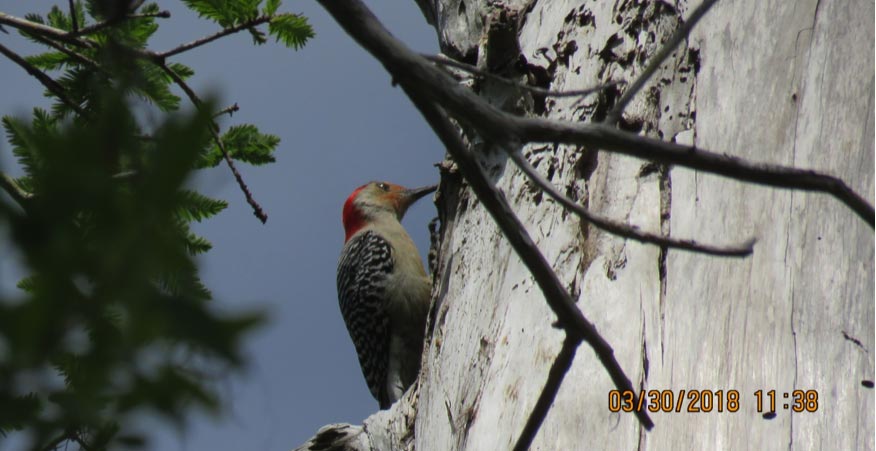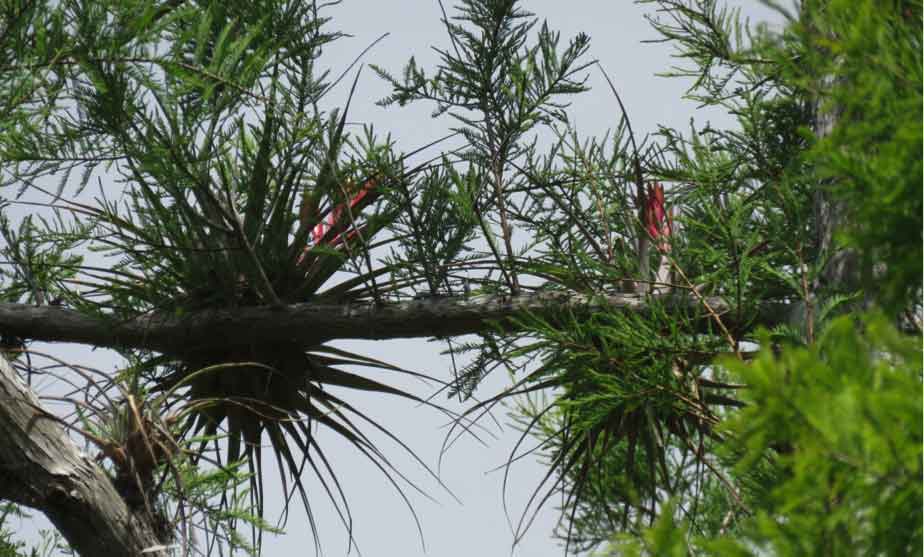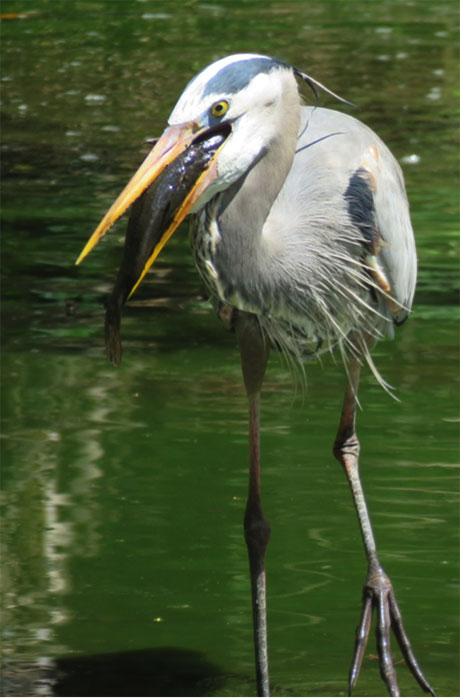By Andrew Tyler
Whether you’re a regular seasonal visitor to Southwest Florida or a year-round resident, being here in 2018 one cannot fail to be struck by the changes in our floral landscape wrought by Hurricane Irma in September 2017. While many of the impacts on personal and community properties have been cleaned up, the effects on trees and their branches along the Boardwalk will be with us for a long time to come.

Blue skies and newly emergent spring growth above the Big Cypress boardwalk, where the loss of canopy is striking.
Examples abound in Naples. The inventory of the City Arborist shows that about 9% of all trees on City property had to be removed after the storm. A second example is the Naples Botanical Garden in East Naples. The devastation among the trees and plantings was cleaned up in fairly short order thanks to the Garden’s dedicated professionals, visiting arboreal specialists, and volunteers. What emerged was a landscape now lacking the extensive canopy shade that existed prior to Irma. Many of the perennial plantings, which had been strategically positioned to take advantage of each plant’s preferences for sun and shade now found themselves in a far sunnier spot, and most did not fare well.
With these thoughts in mind, the last Friday in March presented an opportunity for me to visit the Big Cypress Boardwalk. Visitors are thinning out and the perennial spring changes to our flora are underway. I had not been on the boardwalk often this season, so it was a good opportunity to observe what’s different this year.
You are likely well aware that some of the Friends of the Fakahatchee worked diligently to clear and repair the boardwalk and trail in the second half of September. The evidence of their hard work can only be fully appreciated when one compares what we see today with the scene immediately afterwards, documented in this report by Patrick Higgins. The new Chickee immediately adjacent to the start of the Boardwalk is a great addition. I noticed it being enjoyed by at least two parties of visitors during my visit.
Gazing into the sky, as with the Naples Botanical Garden, the loss of canopy cover is quite striking. While many of the big trees have survived the onslaught, a lot of branches must have been lost to allow through the amount of light we see today. The impacts of increased illumination on the vegetation below remain to be seen.

Red bellied woodpecker, much easier to see with less vegetation, inspect a pre-Irma dead tree, with newly-emerged Cypress needles in the background.
A ‘silver lining’ from the visitor’s perspective, however, is that it’s now much easier to see what’s going on in the lower-to-mid-levels of the vegetation. Whereas in the past one would hear a lot of scurrying around and bird activity, being able to identify their sources depended largely on luck and perhaps some knowledge of bird song. Today it’s much easier to see even the smaller birds scurrying around, and the views of the epiphytic plants are far superior.
We’re at the end of the usual Bromeliad blooming season, but there were numerous cardinal air plant (Tillandsia fasciculata) examples along the boardwalk still in full bloom. Raising one’s eyes from the ground, the epiphytes that enjoy the 10-20 ft off the ground zone are also thriving. Many of the needle-leaf epiphytes are showing that reddish tinge that goes with the time of year.

A collection of epiphytic bromeliads enjoying life in the upper canopy at Big Cypress Boardwalk.
There are two epiphytic dingy star orchids that live close to the far end of the boardwalk; one has red leaves and the other has green. Both were flowering on the day of my visit, and it is interesting to note that they are blooming somewhat later than the examples of the same species we observe on the weekly swamp walks 3 or 4 miles to the north. Why this might be is mere speculation, but they are thriving. One hopes that they continue to do so during the summer, since they will surely receive far more summer solar radiation now than a year ago.

Two dingy star orchids (Epidendrum amphistomum), Red-leaved (left) and Green-leaved (right), in full bloom just off the boardwalk.
At ground level I noticed a lot of ferns thriving in the areas currently lacking standing water. There have always been ferns here, of course, but whether they’re more noticeable because they enjoy the changed circumstances, or merely appear so because it is so much brighter remains to be seen.
Reaching the platform by the alligator hole, I noticed the local large alligator in mid-pool, just finishing lunch. My guess is it was a turtle, judging from the delicious ‘crunching sounds’ coming from the mouth end, but it declined to surface again for a photo opportunity.
A single blue heron was the only wading bird present and patience was rewarded, for the bird succeeded in catching a tasty fish for lunch. I’m always astonished at the seemingly impossible size of fish these birds manage to swallow. There seems to be a certain amount of stunning the fish (or killing it) by ‘slapping it around’ beforehand, presumably so that it doesn’t wriggle so much on the way down. This bird was kind enough to demonstrate, then pose dramatically for photo opportunities before finally downing the fish.
A family of Florida banded water snakes appeared to be in residence, and their relatively small sizes suggest that these are perhaps one year olds. I did not get an accurate count of their number; there was a lot of coming and going around their favorite log. I would estimate six animals visible during my stay.

A juvenile water snake enjoying a swim in the alligator hole. Fortunately the snake was a sufficient distance from the heron to avoid being a lunch target!
A striking difference this year is the color of the water in the alligator hole. The water is very obviously green. Presumably this is a result of increased light levels at the water’s surface allowing enhanced photosynthesis among both algae and small plants. Not my area of expertise, but the coloration seemed restricted to the water itself, as opposed to small clumps of duckweed, for example. This leads me to assume we’re looking at the results of enhanced algal growth.
Algal growth could have positive or negative consequences for life around the pond, or both, or none at all! Most Floridians are aware of ‘red tide’ at the beaches. Red tide is caused by marine algae Karenia brevis, that under certain conditions undergo rapid growth, a process also known as ‘blooming’.
Less well-known is the fact that freshwater algal blooms pose more of a human health threat. Some, but not all, species of freshwater algae can release chemicals that are highly toxic to most animals, including humans. These events can happen anywhere in North America. For example, Toledo, Ohio had to shut down its civic water supply in 2014 as a result of toxic algal blooms on Lake Erie.
These algal blooms are usually caused by abundance of nutrients and sunshine. In Florida, Lake Okeechobee annually suffers this problem to varying degrees, because of nutrients present in the lake’s waters as a consequence of local agricultural practices.
If the bloom uses up certain nutrients, it can cause the algae to die. Although algal blooms oxygenate water as a bi-product of photosynthesis, mass decomposition can lead to oxygen depletion and fish-kill. Blooms can also shade the aquatic plants growing beneath the surface and reduce their growth opportunities. It’s clearly very complicated, but it will be interesting to keep eyes on the alligator hole to see if there are any noticeable longer-term consequences to this mini-ecosystem.

I highly recommend taking some time to check out the Boardwalk of our favorite State Park before the mosquitoes hatch. I’d love to hear about your own observations.
Andrew Tyler, shown here at the Grand Canyon, was elected to the FOF Board of Directors this spring.

